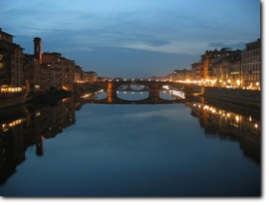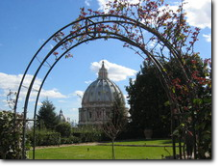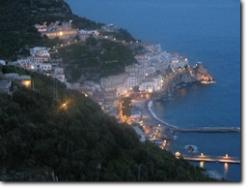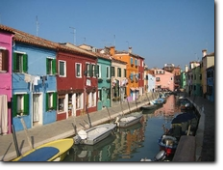Renaissance Rome | Baroque Rome | The Palaces of Rome Nobility | Rome Travels - Rome Travels | Home | Rome Guide | Rome Tours | Rome Travel | Religious Holidays | Italy Pilgrimages | Italy Shore Excursions




Main menu:
Renaissance Rome | Baroque Rome | The Palaces of Rome Nobility | Rome Travels
From the Fall of the Roman Empire until the Italian Renaissance. Arts & Master Pieces in Rome: The Middle Ages (476 - 1417)
Throughout the Middle Ages the City of Rome knew an impressive implosion -and, parallel, the rising of the hundreds of realities in the suburbs of Rome of the little towns and in the Lazio Region -. People never think that Rome "made" the history as well the Middle Ages or that there is a Medieval Rome. In fact, there are only few isolated cases - Churches and cloisters for the most - that were erected during the period of the Greek Popes (VII-VIIIth Cent. ), the Charle Magne epopee (IXth Cent.) and the Ottonian dinasty (Teutonic, Xth Cent.). This period is called "High Middle Ages", before the end of the first Millennium.
Some great exceptions as well are represented in the "Low Middle Ages" by Pope Pascal II (1099-1118), erecting three gems in Rome (mosaics of: Santa Maria in Domnica - Santa Cecilia - Santa Prassede); Onorius IV (1285-87), commissioning the Mosaics of Santa Maria Maggiore, Santa Maria in Trastevere, San Paolo Fuori le Mura, San Giovanni in Laterano.
The Rebirth of Rome through the Papacy: Popes Martin V (1417-31), Nicolas V (1447-55), Sixtus IV (1471-84)
It was only thanks to the above three Popes that Rome, once again, in the XVth Century, second only to Florence, regained the European supremacy in Arts, History and Architecture inaugurating the "Renovatio Urbis" (Renovation of the City).
Pope Martin V with the Cathedral of Rome; Nicolas V in the Vatican and especially Pope Sisxtus IV remodeled the city according to the New Deal of Rome: The Capitoline Museums (first public museum in the World), the Apostolic Library and the Sistine Chapel in the Vatican and the first public Hospital in Rome (Santo Spirito in Sassia).
Rome started to change its image from and old city to a more modern one and Popes tried to give successfully this new image to the Eternal City calling the best artisits who were mainly working in Tuscany.
Renaissance Rome : the reasons of a walking tour through the alleyways, squares, fountains, flavours, wineries, trattorie, Palaces and Churches throughout the Rome of the XVth and XVIth centuries
We don't want to be the ultimate resource of the Renaissance Rome & walking tours of Rome, as there are too many companies who offer similar tours being also quite cheaper than us.
We always wanted to be original proposing a detailed itieneraries that made the history of Rome in the Renaissance, through which our customers can fully embrace the spirit of our Capital of Italy. It can be in hidden alleyways, in an old Roman Osteria being surrounded by the vestige of Ancient Rome, in a small square or just around the corner where there is a great fountain right in front an imposing Palace of the Nobility and, of course, in some fabolous churches of Rome off-the-beaten paths. This is the Renaissance in Rome.
We blame the visitors who want to copy the below itieneraries and do on their own, as they will not get ever the reasons of our City and the full insight.
Renaissance Rome - Tour 1 - Walking Tour of Rome
Piazza del Popolo - Via del Babuino - Via Margutta (Antique stores of Rome) - Piazza di Spagna (Spanish Steps) - Villa Medici - Largo del Nazareno - Piazza San Lorenzo in Lucina - Piazza Colonna - Piazza di Montecitorio - Piazza Capranica - Piazza della Minerva with the Basilica of Santa Maria Sopra Minerva - Piazza della Pigna - Piazza di Tor Margana - Piazza del Campidoglio (Capitol Hill) - Venice Palace.
Duration: appx. 4 hours
Renaissance Rome - Tour 2 - Walking Tour of Rome
Piazza del Campidoglio (Capitol Hill) - Jewish Area - Via dei Giubbonari - Piazza Campo dei Fiori - Piazza Santa Maria della Quercia - Piazza Farnese - Via Giulia - Piazza and Palazzo della Cancelleria (Vatican Chancery) - Via del Pellegrino - Via di Monserrato - Tiber Island - Via della Lungara (Trastevere) - Via di Santa Dorotea - Villa La Farnesina (outside or inside, being a Museum) - Piazza Santa Maria in Trastevere and its surrounding areas.
Duration: appx. 4 hours

Baroque Rome : the golden Century of Rome, embleme of the opulence of the Palaces of the Nobility of Rome and of the magnificience of the Church of Rome through its main interpreters: Bernini, Borromini and Maderno: the XVII Century
The Baroque walks are the complement of what in Rome had been done in the past two centuries: the rebirth of Rome. The Renaissaince of Rome gave the chance to the Papacy through the Nobles of Rome to get rid of the Dark Ages.
Instead, in the Baroque period (XVIIth Century) the Popes showed now all their reaffirmed authority in the European Capitals through opulent Churches, expression of the Inquisition time and magnificient Residential Palaces, the Palaces of Rome, veritable private museums. This New Deal in the Baroque had, amongst others, its three main interpreters: Gian Lorenzo Bernini, Francesco Borromini and Carlo Maderno.
Baroque Rome - Tour 1 - Walking Tour of Rome
Barberini Palace - Church of San Carlino al Quirinale - Church of S. Andrea al Quirinale - Quirinale Palace - Church of St. Silvester to the Quirinal - Ludovisi Palace - Colonna Palace - Pallavicini-Rospigliosi Palace - Odescalchi Palace - Basilica of Ss. Apostoli - Church of Jesus - Church of St. Ignatius
Duration: appx. 4 hours.
NOTE: In some occasion, the visit will be necessary from outside due to the private residences of the Palaces of the Nobility.
Baroque Rome - Tour 2 - Walking Tour of Rome
Doria-Pamhilj Gallery in Via del Corso - Doria-Pamphilj Palace in Piazza Navona - Navona Square & Bernini's Foutain of the Four Rivers - the Senate House at Palazzo Madama - Via del Governo Vecchio - Ponte S. Angelo (Bernini's Bridge of the Angels) - Via dei Coronari (Antique stores in Rome) - Piazza San Salvatore in Lauro - Piazza Lancillotti - Santa Maria della Pace - Via del Fico - Via dei Banchi Nuovi.
Duration: appx. 4 hours.
Renaissance and Baroque Rome - Walking Tour - The costs - Also tour combination for any tour
1 - 6 people: EUR 325,00
7 - 14 people: EUR 450,00
15 - 20 people: EUR 40,00 per person
21 - 40 people: EUR 30,00 per person
NOTES:
1) Each half day will be made out of 4 hours of full guided tour with your private and official tour guide of Rome.
2) In order to have a better and more enjoyable tour, in case of more than 15 people, we highly recommend the rental of the head-sets (mandatory also to see any Church in Rome).
3) 21 % VAT tax NOT INCLUDED IN THE ABOVE COSTS
Renaissance and Baroque Rome - Walking Tour - The costs - 8-10 hours tour -
Also tour combination for this walking tours
1 - 6 people: 900.00 EUR
7 - 14 people: 1,200.00 EUR
15 - 20 people: 75.00 EUR per person
21 - 50 people: EUR 50.00 per person
NOTES:
1) Each Full day will be made out of 8 hours of full guided tour with your private and official tour guide of Rome.
2) In order to have a better and more enjoyable tour, in case of more than 15 people, we highly recommend the rental of the head-sets (mandatory also to see any Church in Rome).
3) 21 % VAT tax NOT INCLUDED IN THE ABOVE COSTS
